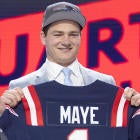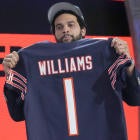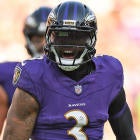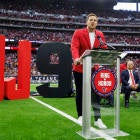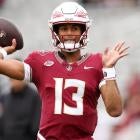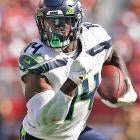
The NBA is expected to decrease the age requirement to enter the NBA Draft from 19 years old to 18, undoing a guardrail that has been in place since the 2005 Collective Bargaining Agreement. The change can take effect as early as 2024, paving the way for players out of high school to turn professional without having to fulfill the requirement of spending one year removed from high school.
The NFL has established a three-year rule, meaning prospects must be at least three years removed from high school to enter the draft. It was initially collectively bargained by the NFL and NFLPA after former Ohio State running back Maurice Clarett sued the NFL in 2003 for restricting his right of employment and was most recently upheld in the 2020 Collective Bargaining Agreement.
In 2015, Pro Football Talk's Mike Florio wrote that "the league bases its position in part on its belief that the physical, mental, and emotional demands of pro football would make it nearly impossible for someone to have success in the NFL at an earlier age. ... The more accurate reason for the NFL's position is that the league wants to protect its free farm system."
The premise of the story strengthened last season when some of the NFL's most impactful players -- Cowboys edge rusher Micah Parsons, Bengals wide receiver Ja'Marr Chase and Chargers left tackle Rashawn Slater -- sat out their final collegiate seasons. They did not need that extra year to prove themselves.
Leaving as soon as possible may no longer be in the best interest of some players, however. Name, Image and Likeness (NIL) has changed how college athletes are viewed. There are players more suitable for the college game than the professional game, so the new pay structure allows them to profit at a level that may never have been possible in the NFL. Consider the amount of money Tim Tebow and Johnny Manziel could have earned at Florida and Texas A&M, respectively. Troy Smith, Eric Crouch and Jason White were others who won a Heisman Trophy but had little more than a cup of coffee at the next level. The NFL no longer has to protect young players from making poor financial decisions as some suggest.
There is no all-encompassing rule that serves the chief interest of all. As Cardale Jones once said, "We ain't come to play school." At some point, a young person has to make a decision that they feel is best for their future, while the NFL currently supports a three-year rule.
The story is not to advocate for a shorter service requirement but rather to lay out the facts and, in some cases, opinion.
Positions best and least suited for a shorter service requirement
Running back is almost assuredly the position that would benefit the most from having a shorter service requirement. For example, Texas running back Bijan Robinson would have been my top-rated running back had he been eligible for the 2022 NFL Draft. Instead, he returns to Austin where he has 75 non-NFL touches this season. The idea that a running back is only capable of taking a certain number of hits in their career has been adopted by the most casual fans and is no longer a belief held by the most cynical in the football community.
It is fun to consider what Adrian Peterson's career could have looked like without a layover in Norman. If three prime years -- mirroring his first three seasons -- were added to his career, he would be sitting at 19,402 career rushing yards; more than 1,000 rushing yards more than the all-time leader (Emmitt Smith - 18,355). In fairness, years could be added to the careers of all others as well.
The least suitable positions for a quick transition to the NFL would be the offensive and defensive lines. The physical gap between high school and NFL linemen is certainly more narrow today than it had been even 10 years ago, and yet it is still rare to find a true freshman starter along a Power Five offensive line. Muscle development and core strength come with maturity.
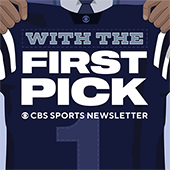
With The First Pick Newsletter
With The First Pick Newsletter
Prepare for the upcoming NFL Draft with the day’s big stories + mock drafts, big board updates and more.
Thanks for signing up!
Keep an eye on your inbox.
Sorry!
There was an error processing your subscription.
Players ready for the NFL prior to eligibility since 2010
RB Saquon Barkley, Penn State
I was always adamant that New York was not in a position to take a running back No. 2 overall in the 2018 NFL Draft, but that should not overshadow the fact that he was deserving. Barkley played three seasons for the Nittany Lions and then he was out the door. He showed lower body strength and burst in highlight-reel plays each week, but he was also the total package. He was passable in pass protection and productive through the air. In his final season, he caught 54 passes for 632 yards and three touchdowns. Barkley's size and skillset translated to the NFL before he was eligible.
EDGE Nick Bosa, Ohio State
Former Ohio State edge rusher Joey Bosa -- Nick's brother -- did most of the heavy lifting. Through power and hand usage, the elder Bosa carved his path into the No. 3 overall selection. It is not uncommon with the draft community to become infatuated with what is next. Not long after Los Angeles selected his older brother, the narrative of "watch out for his little brother" began in earnest. There were assertions of "Nick is even better than his brother." The former was just beginning his true freshman season with the Buckeyes, but the three-year countdown had already begun. Injuries along the way would prevent him from fully realizing his potential as a college football player, but his output in the NFL justifies those early conversations.
RB Leonard Fournette, LSU
Former LSU head coach Les Miles advocated for Fournette in 2015, noting that some players are capable of handling the physical rigors that come with playing professional football.
"I think that there's probably guys that could enter the draft just like basketball, one and out. I think there's a style of athlete that can do that. But I think they're rare because in football, with maturity and strength, it really adds to their worth in what is the next level and the next league."
Eventually taken No. 4 overall in the 2017 NFL Draft, the Louisiana native was dominant for the Tigers in 2015, racking up 1,953 rushing yards and an additional 253 yards through the air. Coming out of high school, he was 6-foot-1, 226 pounds, presenting a challenge for even the most capable SEC defenders.
Running backs are not often taken early in the NFL Draft so the league's willingness to consider him at that stage should give an idea to the type of talent he possesses. If he had entered the draft a few years earlier, he may not have ended up in Jacksonville, where he would ultimately wear out his welcome (not unlike other former Jaguars first-round selections during the Tom Coughlin-era). The perception of Fournette with a Super Bowl contender is much different than the last memory most had of him being waived from the AFC South franchise.
EDGE Myles Garrett, Texas A&M
Photos of Garrett in high school, let alone college, have been circulating long before he was drafted No. 1 overall by the Browns. He was physically ready for the league earlier than most at his position -- even if it was not as a true freshman. Few doubters of his talent existed outside of those looking to deliver a hot, contrarian take, and it has not worked out well for those select few.
Normally, the conversation at No. 1 overall is centered around which quarterback is best prepared to make the competition leap, but Garrett had distinguished himself as an elite talent. The quarterbacks were an afterthought at the time to NFL teams, who were naive to the inevitability that Patrick Mahomes and Deshaun Watson would one day shake up the landscape.
RB Derrick Henry, Alabama
Henry was listed at 6-foot-3, 240 pounds coming out of Yulee High School in Florida. Does that sound like the frame of a player incapable of taking on would-be tacklers in the NFL? Over a three-year period, he recorded 620 offensive touches for the Crimson Tide, which is conservatively two seasons worth in the NFL.
In 2020, the running back signed a four-year deal worth $50 million. If he had arrived in the NFL two or three years earlier, he would have reached that second contract sooner. He could have earned an additional $25-plus million during his career without even considering the marketing potential.
QB Trevor Lawrence, Clemson
A true freshman Lawrence and his Tiger teammates were dominant over Alabama in the national championship. He threw for 347 yards and three touchdowns, kicking off his national campaign. After Year 2, there was discussion that he should skip the college football season and prepare for the NFL Draft rather than risk injury. It does not sound like that was ever a serious consideration for the Georgia native, but he did go wire-to-wire as the top-ranked recruit out of high school to No. 1 overall selection in the 2021 NFL Draft. "It" is not tangible or easy to explain, but it was evident Lawrence possessed 'it' early in his collegiate career. The NFL is seeing that play out with a competent coach at the controls.
QB Andrew Luck, Stanford
Until Lawrence entered the NFL, Luck was the measuring stick for every quarterback. Luck was the best quarterback prospect since John Elway, while Lawrence was the best quarterback prospect since Luck. Those are the statements fans often heard during pre-draft preparation.
Luck was not known for his foot speed but, at the time, it did not matter. Playing in structure with a solid base was the style of the times. His background at Stanford supported the notion that he was an intelligent player capable of making all the necessary reads in the NFL. He validated the optimists by setting an NFL record for passing yards by a rookie quarterback (4,374). Luck actually returned for a fourth season in Palo Alto to the surprise of many, but he was capable.
DL Robert Nkemdiche, Ole Miss
Nkemdiche's inclusion on this list may come as a surprise considering some of the other names, but he was a highly regarded high school recruit out of Loganville, Georgia. At 6-foot-4, 285 pounds, Nkemdiche was an anomaly. High school recruits are not supposed to possess the size and speed (verified 4.65 seconds 40-yard dash, according to 247Sports) he boasted. In an article from ESPN, he was dubbed "the Southeast's best prospect since the early 1980's" and "a younger version of Reggie White." Despite his collegiate career failing to live up to expectations, the Arizona Cardinals used the No. 29 overall selection in the 2016 NFL Draft on him -- a byproduct of the hype generated years earlier. If he had entered the league a year sooner, he would not have had a run-in with the law on his pre-draft resume. It is safe to say that had some level of impact on how he was perceived by those around the league, and his draft prospects were worse as a result.
CB Derek Stingley Jr., LSU
Stingley was a true freshman sensation, locking down the SEC's top wide receivers. Over the next two seasons, he battled injury and the disappointment that came with those post-National Championship teams. A lot happened in Baton Rouge once Joe Burrow departed. Stingley had the talent, but not the opportunity to join him earning life-changing money on Sundays until a few years later.
QB Tua Tagovailoa, Alabama
Remember #TankForTua? Perception of the Alabama quarterback was different from the beginning of his final season to the end. Unfortunately, injury did impact his journey. After leading the Crimson Tide to two consecutive national championship appearances, Tagovailoa suffered a high ankle sprain and a more significant injury in which he was carted off the field at Mississippi State. Those visions, the unknown pertaining to his injury and the rise of Joe Burrow, made Tagovailoa available at No. 5 overall. If he had been available a year sooner, would he have been Arizona's choice at No. 1 overall instead of Kyler Murray?
Entire top 6 of the 2011 NFL Draft
Auburn quarterback Cam Newton, Texas A&M edge rusher Von Miller, Alabama defensive tackle Marcell Dareus, Georgia wide receiver A.J. Green, LSU cornerback Patrick Peterson and Alabama wide receiver Julio Jones had a lot of fanfare in 2011, and it is safe to say they lived up to the expectations. Statistics and financial earnings obviously would have benefitted from additional time in the league.
The particular group in question has one unfortunate similarity, though. They were the first draft class to feel the impact of the rookie wage scale adopted as part of the 2011 Collective Bargaining Agreement. In 2010, Sam Bradford signed a six-year deal worth $78 million ($13 million average annual value) as the No. 1 overall selection. A year later, Newton was taken No. 1 overall, but his contract looked significantly different. He signed a four-year deal worth $22 million ($5.5 million average annual value). Newton's situation was different because of his decision-making at Florida and the path he took as a result. Could he have turned pro after two seasons rather than four? Dareus, Green, Peterson and Jones all spent exactly three seasons in college. They did not have the opportunity to join the NFL prior to the rookie wage scale. It does not require a mathematician to compare the financial impact.































